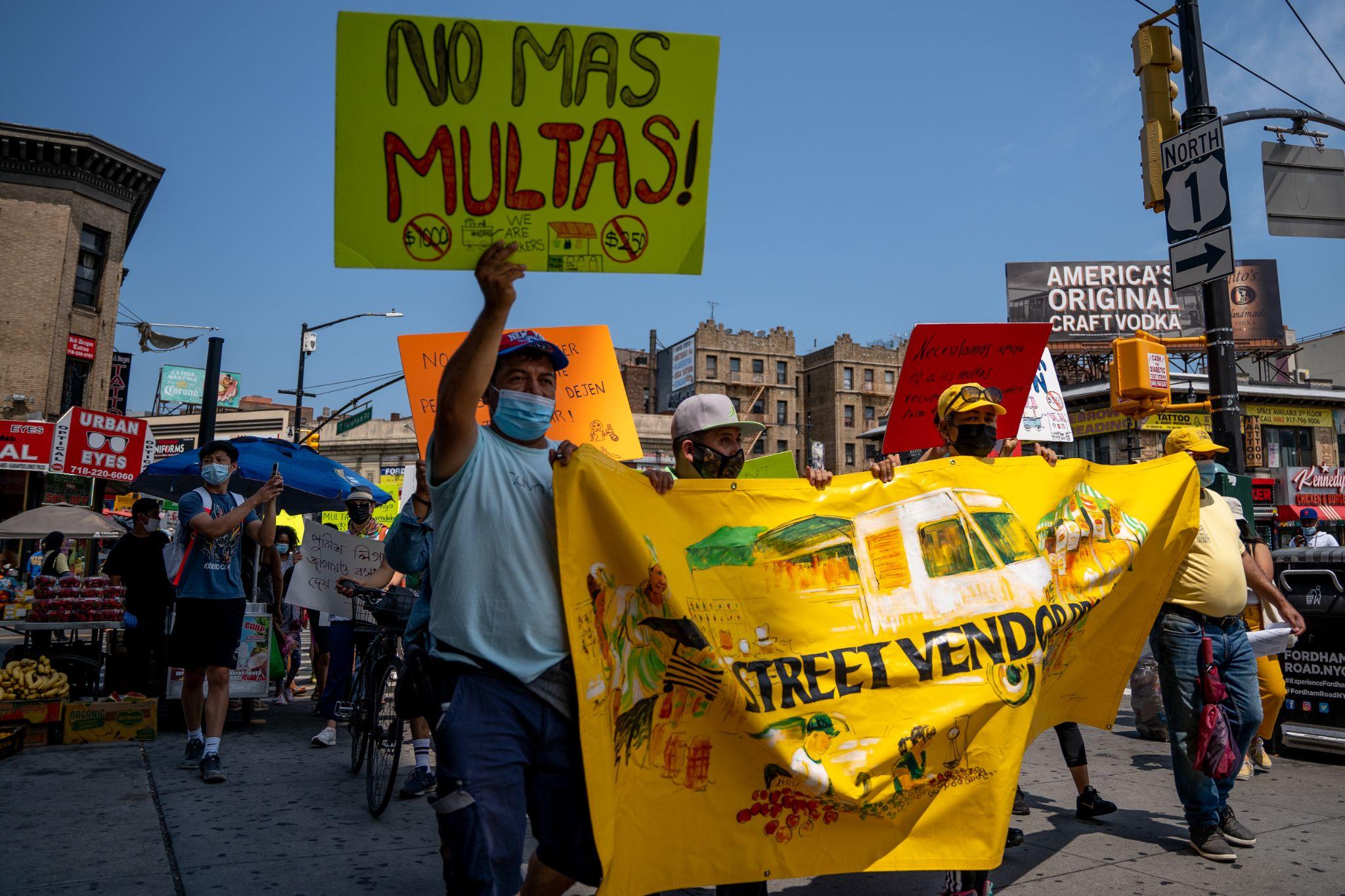But others say the rules are fair, and must be enforced
Justina Rios and her husband Felix wake up in their Longwood apartment every weekday morning before 5 a.m., to prepare to ply their trade. Justina, 57, prepares 50 tamales and a few dozen sandwiches and quesadillas. Felix, 50, then loads them in their cart, which he then walks down the 5 train stairs, to ride to the same spot in front of a midtown skyscraper, where he sells the Oaxacan delicacies to construction workers starting the morning shift.
After selling out, Felix rushes home, where Justina arms him again, this time with lunches to bring to the same spot.
Justina and Felix are among the estimated 20,000 street vendors citywide who sell everything from Dominican ices to jewelry, and played a key role in the metropolis’ scaled-down daily street life during the pandemic.
But as the city continues re-opening, the vendors say city government is taking an unfair cut out of their livelihoods, in the form of steep fines, arbitrary enforcement, and a confusing licensing process.
Vendors say they have a subculture of their own, and feel one another’s stress. Rios sometimes stops to buy food from fellow South Bronx vendors.
“I tell them it’s because I want you to make it,” she says. On a recent weekend, a fruit vendor in The Hub told her he had been fined $1,000. Justina, who had come to sell some second-hand clothes, moved to a different spot to spare herself a similar fate.
“I said to him, ‘wow, how can you pay that?’ If I make $300 in a day selling tamales, easily more than $100 is to buy the ingredients.”
Although fines for selling without a license can range up to $4,000, a long standing cap on the number of licenses issued has led to many vendors “leasing” licenses on the black market, often costing them tens of thousands of dollars. The City Council in January passed legislation increasing the number of licenses granted, from 2,900 to just under 7,000 over the next decade. Some see it as a half-measure. Others aren’t that optimistic. Even among vendors, there is disagreement about how to solve the myriad of problems they face and what the new law will bring.
“Unfortunately, the authorities throughout this business district presented a document stating that we’re going to be removed,” said Vicente Veintemilla,who sells bracelets, charms and sandals in Fordham Heights.
“What this means is that sooner or later, outside of being removed, they will confiscate our merchandise and we will also be fined. We will be without a job,” said Veintemilla, who says he has been fined thousands of dollars, for supposed violations he said weren’t made clear to him.
Veintemilla, a member of the Street Vendors Project, which organizes vendors to help navigate the legal system, played a role in pressuring the City Council to create legislation to protect them. The group now has its sights set on getting more bills passed at the state level. The organization’s managing director, Mohamed Attia, says the cap on licensing is arbitrary, and puts vendors at risk.
“The solution of the problem is very easy,” said Atia at a vendors protest in Harlem in July. “You can simply lift the caps. Get everyone to get the permits and licenses they need, so everyone can be in the system legally.”
Atia, a former vendor himself, says that by capping the number of licenses artificially, the city is pushing vendors onto the black market, thereby forcing them to lease licenses to each other at massive markups.
Luis Vidal, 60, an Ecuadorean who lives Queens and sells jewelry from the colonial city of Cuenca in The Hub, says the fines the city issues now are “unjust because we lost so much business during the pandemic.”
“We need an authority to help us because [vendors] are disorganized,” said Vidal. “We’re scared.”
But not all street vendors agree with every position the advocacy group and its members take. Maria Maradiata, who has sold ices from a cart in The Hub for more than a decade, says she sees both sides of the issue, and that although vendors need to make a living, they should abide by a set of rules like everyone else.
“Vendors should get fined if they don’t have proper equipment,” said Maradiata, adding that in recent years enforcement officials have been more lenient toward her and her fellow street sellers, urging violators to move along rather than issuing knee-jerk fines.
“Some vendors take too much space,” she said while manning her ices cart during a hot, busy afternoon in late July, and motioning to the north side of 149th Street. “Some of them take big parts of the sidewalk and no one can get by.”
Michael Brady, executive director of the Third Avenue Business Improvement District, says The Hub is tough enough to navigate without the chaos of unregulated vendors setting up carts wherever they please. Between construction scaffolding at construction projects, to the roughly 400,000 pedestrians who traverse the area’s main business artery every day, The Hub is already congested enough, he says. Permitting more vendors or further loosening regulations would make it even grittier for businesses and pedestrians. Fines for vendors, Brady suggested, should be the same as for brick and mortar businesses, and added that advocates are creating a false narrative by pitting street vendors against storefront businesses.
“Shouldn’t our goal be to get people off the street and into a brick and mortar store?” he said. “Shouldn’t we say, ‘hey, street vendors, here are a bunch of vacancies, we’re going to increase your capacity, and we’re going to make it so you can afford the rent to be in a brick and mortar shop, and add to the the economic development and the property tax base? Why the city of New York doesn’t start a social entrepreneurship program for street vendors to get them into brick and mortar is beyond me.”

